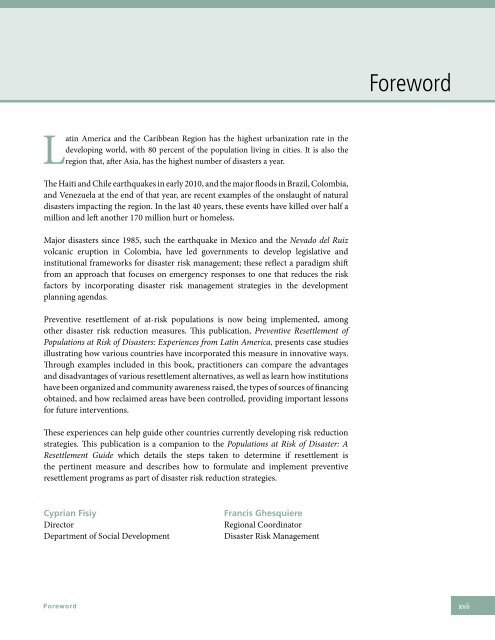Preventive Resettlement of Populations at Risk of Disaster - GFDRR
Preventive Resettlement of Populations at Risk of Disaster - GFDRR
Preventive Resettlement of Populations at Risk of Disaster - GFDRR
You also want an ePaper? Increase the reach of your titles
YUMPU automatically turns print PDFs into web optimized ePapers that Google loves.
Foreword<br />
L<strong>at</strong>in America and the Caribbean Region has the highest urbaniz<strong>at</strong>ion r<strong>at</strong>e in the<br />
developing world, with 80 percent <strong>of</strong> the popul<strong>at</strong>ion living in cities. It is also the<br />
region th<strong>at</strong>, after Asia, has the highest number <strong>of</strong> disasters a year.<br />
The Haiti and Chile earthquakes in early 2010, and the major floods in Brazil, Colombia,<br />
and Venezuela <strong>at</strong> the end <strong>of</strong> th<strong>at</strong> year, are recent examples <strong>of</strong> the onslaught <strong>of</strong> n<strong>at</strong>ural<br />
disasters impacting the region. In the last 40 years, these events have killed over half a<br />
million and left another 170 million hurt or homeless.<br />
Major disasters since 1985, such the earthquake in Mexico and the Nevado del Ruiz<br />
volcanic eruption in Colombia, have led governments to develop legisl<strong>at</strong>ive and<br />
institutional frameworks for disaster risk management; these reflect a paradigm shift<br />
from an approach th<strong>at</strong> focuses on emergency responses to one th<strong>at</strong> reduces the risk<br />
factors by incorpor<strong>at</strong>ing disaster risk management str<strong>at</strong>egies in the development<br />
planning agendas.<br />
<strong>Preventive</strong> resettlement <strong>of</strong> <strong>at</strong>-risk popul<strong>at</strong>ions is now being implemented, among<br />
other disaster risk reduction measures. This public<strong>at</strong>ion, <strong>Preventive</strong> <strong>Resettlement</strong> <strong>of</strong><br />
<strong>Popul<strong>at</strong>ions</strong> <strong>at</strong> <strong>Risk</strong> <strong>of</strong> <strong>Disaster</strong>s: Experiences from L<strong>at</strong>in America, presents case studies<br />
illustr<strong>at</strong>ing how various countries have incorpor<strong>at</strong>ed this measure in innov<strong>at</strong>ive ways.<br />
Through examples included in this book, practitioners can compare the advantages<br />
and disadvantages <strong>of</strong> various resettlement altern<strong>at</strong>ives, as well as learn how institutions<br />
have been organized and community awareness raised, the types <strong>of</strong> sources <strong>of</strong> financing<br />
obtained, and how reclaimed areas have been controlled, providing important lessons<br />
for future interventions.<br />
These experiences can help guide other countries currently developing risk reduction<br />
str<strong>at</strong>egies. This public<strong>at</strong>ion is a companion to the <strong>Popul<strong>at</strong>ions</strong> <strong>at</strong> <strong>Risk</strong> <strong>of</strong> <strong>Disaster</strong>: A<br />
<strong>Resettlement</strong> Guide which details the steps taken to determine if resettlement is<br />
the pertinent measure and describes how to formul<strong>at</strong>e and implement preventive<br />
resettlement programs as part <strong>of</strong> disaster risk reduction str<strong>at</strong>egies.<br />
Cyprian Fisiy<br />
Director<br />
Department <strong>of</strong> Social Development<br />
Francis Ghesquiere<br />
Regional Coordin<strong>at</strong>or<br />
<strong>Disaster</strong> <strong>Risk</strong> Management<br />
Foreword<br />
xvii
















